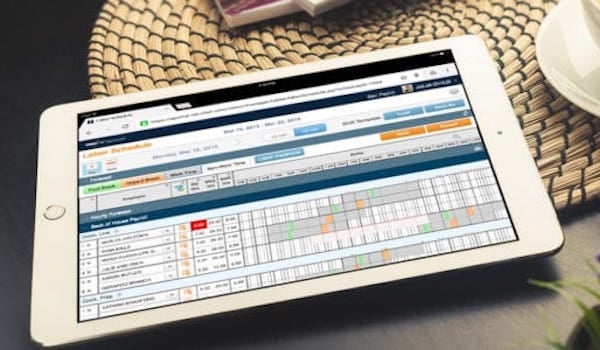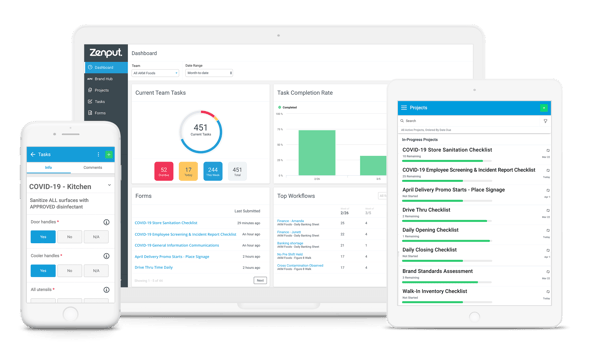
- Home
- Crunchtime Blog
- 5 Operational Forms You Should Be Using in Your Restaurant

5 Operational Forms You Should Be Using in Your Restaurant
Forms are the heartbeat of execution in any restaurant operation—they allow brands to standardize procedures across many locations, create a simple way for employees to follow necessary steps, and collect information that field teams and corporate offices need visibility into.
If you use an operations execution platform, there are several must-have forms that are fundamental to daily operations. Whether you’re creating these forms for the first time or improving existing ones, make sure you’re using these five forms and borrowing ideas to optimize your current form fields.
If you’re a Zenput customer, you can follow the link included under each form idea to learn more about how to set it up in Zenput specifically. In some cases, there will even be a form code that you can reference to your customer support manager (CSM) to help them automatically populate that form in your Zenput account.
1. Restaurant walk form
A Restaurant/Store Walk is a structured way to enable leadership to assess the day-to-day operations of a store. By implementing a repeatable and verifiable process, managers and owners can detect potential issues early on, streamline operations, and ensure a top-notch customer experience.
Your checklist should reflect your highest-priority SOPs and include items related to cleanliness, organization, safety, customer service, and marketing. Use these ideas to get started building a walkthrough of your own.
Fields to include:
- Location Exterior - Is your location presentable, well-kept, and in good condition? Are relevant promotional materials in place?
- Team Members - Are they exhibiting satisfactory customer service skills? Is their attire appropriate? Are they following standard operating procedures?
- BOH/FOH - Do the inside standards match the outside? Ensure anything intended for your customers and/or team to complete their daily tasks is ready to go.
- Food Quality Service - Are stations holding meat, vegetables, and other food products up to cleanliness standards? Are these food products being properly handled?
- Restrooms - Are the restrooms clean, stocked, well-lit, and functioning correctly?
- Team Information - Is the necessary team member information data being collected (feedback, name, employee ID, signature, etc)?
If you use Zenput, use these steps to build a walkthrough form for your brand.
2. Food safety check form
Food safety incidents often incur significant costs and have a lasting effect on your restaurant’s brand. Consistently staying on top of storage and handling of food products is critical to identifying potential issues and mitigating them before they become a crisis.
Borrow these fields on temperature checks and food safety standards to create a food safety check form that can help identify food safety risks and prevent incidents.
Fields to include:
Food Safety Standards
- Food contact areas have been cleaned and sanitized (make-line surface, dishes and pans, grills and stovetops, utensils, and other kitchen equipment)
- Non-food contact areas are clean and in good condition (walk-in cooler shelves and doors, kitchen floors, cashier counter)
- Soap dispensers in the kitchen area are full
- Employees wash their hands at least at the top of every hour and use the proper handwashing technique.
- No evidence of pest infestation
- Raw meat and poultry cooked to proper internal temperature
- No expired products present (learn about the Zenput Labels food prep labeling solution here)
- Sanitizer used in dishwashing procedures are at the proper concentration (100PPM)
Temperature checks for recommended temperatures
- Walk-in cooler temperatures (between 35℉ and 38℉)
- Reach-in cooler temperatures (between 35℉ and 38℉)
- Hot food holding temperatures (at or above 140℉)
- Make-line temperatures (between 33℉ and 40℉)
If you use Zenput, use this guide to create forms like this in your account.
3. Incident report form
Incidents that occur in restaurants when something goes awry on a shift can often be chaotic and emotional experiences for employees. One way to keep order and empower employees who find themselves managing these situations is to equip them with a form that provides clear next steps.
Incident report forms should provide simple step-by-step instructions on quickly and factually documenting the critical information that leaders need when following up with the incident. For a thorough incident report that can help facilitate resolutions and follow-up investigations, make sure it has the following elements.
Fields to include:
- Detailed descriptions of the incident itself (what, when, where, why)
- Names and information of those involved to follow up
- Statements of those involved to provide a comprehensive view of the incident
- Require photo and video documentation of the incident and aftermath to ensure your teams are documenting everything possible at the time of the incident
- Require sign-off of leaders present
To learn more about building this form in Zenput, as well as how to use automation to announce the form or create follow-up triggers from submitted forms, visit this guide.
4. Cleanliness reminder form
For best practices that occur randomly throughout the day, like washing hands after touching money, creating a form that asks employees to document their handling of the situation each time can often be inefficient. Instead, creating reminder forms can be a creative way to reinforce these best practices. Reminder forms keep these practices top of mind after completing every form but prevent them from becoming cumbersome.
Use the following ideas for fields to remind employees about a cleanliness reminder form periodically. These fields can simply be accompanied by a “yes” or “no” check after employees have read each one.
Fields to include:
- Ensure that anyone handling food washes their "hands with warm water and soap for at least 20 seconds" in the following cases:
- After using the restroom
- Clearing tables and/or busing dirty dishes
- Taking out the garbage
- After eating, drinking, or smoking
- Handling chemicals that might affect food safety
- Touching body or hair
- Handling money
- Sneezing, coughing, or using a tissue
- Wash and clean all cutting boards and surfaces, such as utensils, dishes, and countertops that come into contact with food with hot soapy water
- Rinse all fresh fruit and vegetables under running water; scrub firmly with a produce brush
- Remember to change your single-use gloves regularly
- Separate raw meat, poultry, seafood, and eggs from each in the refrigerator
- Use one cutting board for produce and another for meats such as meat, poultry, and seafood
- Never reuse marinades used on raw foods unless they are brought to a boil first
- Never reuse a plate that previously held raw food or eggs unless it has been washed in hot soapy water
Find more information on building this form in Zenput in this article, or reference any of the forms in the article to your Zenput CSM to have them copied into your account.
5. Employee health and wellness check
Following the COVID-19 pandemic, employers and customers alike have new and heightened standards for containing possible illness in each location to minimize risk and provide a safe experience for all guests. An employee health and wellness check is a great way to scale a standardized, objective check of key symptoms that may pose a risk.
Fields to include:
- Employee name
- Temperature reading
- Has been in contact with someone exhibiting these symptoms:
- Fever
- coughing
- Sneezing
- Shortness of breath
- Is currently experiencing these symptoms
- Fever
- coughing
- Sneezing
- Shortness of breath
Read this article for tips on setting up this form in Zenput and instructions on setting up triggers that report on actions taken with sick employees.
After creating or improving these five critical forms at your restaurant, we encourage you to examine what other processes could be standardized with forms or what crucial information leaders are missing that could be collected with form responses. For more information on Zenput and how you can leverage the platform for execution and visibility on these processes, book a demo.
Share this post
Related


10 Signs You've Outgrown Your Restaurants' Scheduling Vendor



